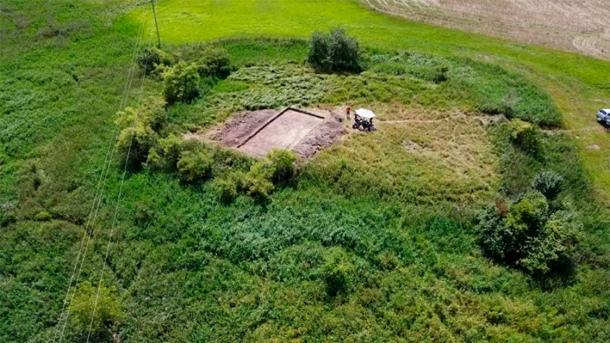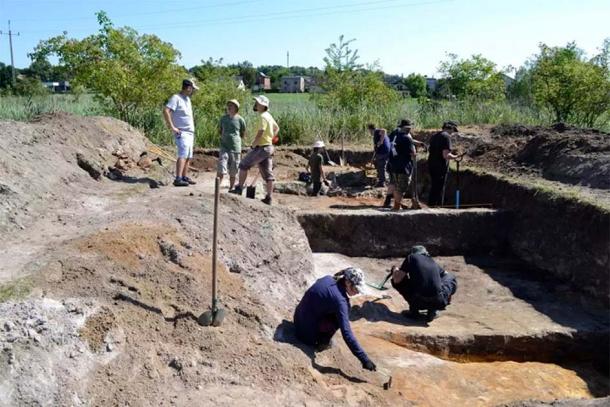
Polish Archaeologists Find Rare Reliquary Belonging to a Medieval Knight
The “first fully systematic study of mound relics” in Poland’s Wozniki, a stronghold, has led to the discovery of a rarely encountered encolpion, i.e., a cross-shaped reliquary, from the structure that was a medieval knight’s residence. A range of artifacts were unearthed in the process that were made of clay and iron: door fixtures, a padlock, a key, nails, hooks, staples, and a carder.
Military Affirmations: A Knight’s Stronghold of Note
In addition, the presence of military-related items was affirmed through the discovery of three iron stirrups, a portion of a horseshoe, numerous crossbow arrowheads, and remnants of cordage. The excavation also yielded several silver coins and components of a belt ensemble, reports Science in Poland (PAP).
Situated in Lubliniec County, Poland, this structure served as the residence of a knight during the 14th to 15th century. Its historical significance was initially investigated during the mid-19th century by the Archaeology Department of the Upper Silesian Museum in Bytom. It likely burnt down during the first half of the 15th century, though the reasons for this have not been discerned.
- Archaeologists Find ‘World’s First’ Golden Cross, But Will it Contain Fragments of the Cross of Jesus?
- France and England Didn’t Own Chivalry: Have You Heard of the Polish Knight Zawisza Czarny?

Archaeological site in Woźniki, bird’s-eye view. (Institute of Archeology of the University of Lodz)
Over time, extensive agricultural activities have largely obliterated any discernible archaeological remnants on the surface. Nevertheless, a recent geophysical study conducted by researchers from the University of Łódź has unveiled traces of the stronghold and its associated structures.
The preserved remnants of the lower level of a wooden structure, along with the artifacts of a dome furnace that once occupied one of its corners, have also been uncovered. This furnace likely served to heat the interior of the residence. The stronghold was built at the end of the 13th century, with later additions made during the latter half of that era, write the authors in a soon-to-be-published article in Folia Archaeologica.
The archaeological research conducted this year was carried out by students of archaeology from the University of Lodz, guided by Professors from the Institute of Archaeology and Ethnology of the Polish Academy of Sciences in Łódź, the Jan Długosz University in Częstochowa, and Wojciech Kawka from Bytom, highlighting the interdisciplinary nature of the research team.

Excavations underway at the archaeological site. (Institute of Archeology of the University of Lodz)
Encolpion: A Religious Pendant with a Storied History
An encolpion, derived from the Greek words "en" meaning "in" and "kolpos" signifying "breast," was a religious pendant worn by Christians on their chests. Within these pendants, one could find either sacred relics or passages from the Holy Scriptures.
Encolpions (encolpia) held significant symbolism within the Christian faith, primarily worn by Eastern Orthodox and Eastern Catholic bishops. These encolpions came in various shapes, including oval, round, and four-cornered designs, often embellished with gem-like adornments, typically made of imitation jewels. They were typically crowned with an Eastern-style mitre. In antique and historical contexts, the term "encolpion cross" refers to a pectoral cross typically associated with the Byzantine era, reports The Heritage Daily.
- 1,000-year-old Polish Boleslaw Sword Reveals Glorious Knighthood Era
- Noblewoman’s Grave Yields Large Silver Cross with Precious Garnet
Encolpions may contain religious relics, fragments of scripture, prayers, or even a piece of the Eucharist, symbolizing faith and spiritual devotion. High-ranking clergy members, including bishops, wear them as part of their vestments, with the pendants serving as visible reminders of their role as spiritual leaders.
These pendants are consecrated or blessed before being worn, believed to offer protection and blessings to their wearers. Encolpions hold a significant place in the religious and cultural heritage of Eastern Christian traditions and are also appreciated as valuable collectibles for their historical and artistic value today.
Top image: The knight’s rare medieval reliquary – an encolpion. Source: Institute of Archeology of the University of Lodz
By Sahir Pandey
References
Altuntas, L. 2023. A rare reliquary discovered during excavations in Poland. Available at: https://arkeonews.net/a-rare-reliquary-discovered-during-excavations-in-poland/.
Milligan, M. 2023. ARCHAEOLOGISTS FIND A RARE RELIQUARY BELONGING TO A MEDIEVAL KNIGHT. Available at: https://www.heritagedaily.com/2023/10/archaeologists-find-a-rare-reliquary-belonging-to-a-medieval-knight/148928.
Science in Poland . 2023. A rare reliquary discovered during excavations in Woźniki. Available at: https://naukawpolsce.pl/aktualnosci/news%2C98947%2Crzadko-spotykany-relikwiarz-odkryty-w-trakcie-wykopalisk-w-woznikach.html.















